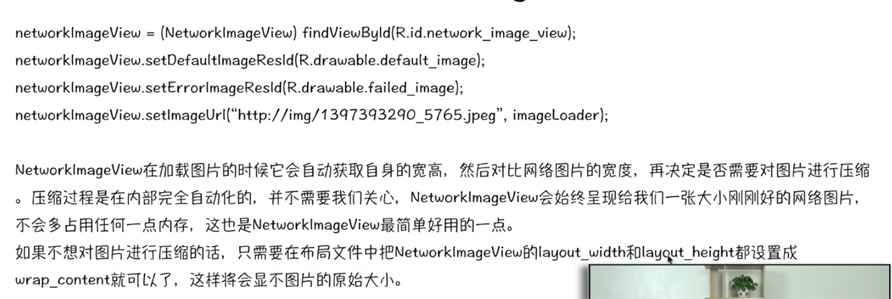您好,登錄后才能下訂單哦!
您好,登錄后才能下訂單哦!
本篇文章給大家分享的是有關Android中Volley和Glide框架如何使用,小編覺得挺實用的,因此分享給大家學習,希望大家閱讀完這篇文章后可以有所收獲,話不多說,跟著小編一起來看看吧。
首先 AndroidStudio中引入Volley三種方法
引入volley.jar文件
添加volley到gradle依賴
compile 'com.mcxiaoke.volley:library:1.0.19'
通過git下載volley,添加為項目module
1:StringRequest
先熱熱身,傳入一個百度鏈接,返回一些數據。
1.1簡單請求一個網絡地址并返回數據,創建隊列
RequestQueue queue=Volley.newRequestQueue(context);
1.2在需要的地方創建StringRequest(參數..)
GET/POST
url地址
響應監聽
錯誤監聽
String url = "http://www.baidu.com";
StringRequest request = new StringRequest(Request.Method.GET,url,new Response.Listener<String>(){
@Override
public void onResponse(String response) {result = SecuritUtil.aesBase64Decode(response); },new ErrorListener() { @Override public void onErrorResponse(VolleyError error) { } }
});1.3最后處理要加入到隊列中
queue.add(request);
我去,這就可以了,我自己都緊張了,記得以前用httpconnect的時候,寫的真的是多,還要配置很多的東西,就連retrofit都要寫注解什么的。retrofit我之前有些文章,不怎么會用的同志可以去看看。好了,數據是出來了,我沒有截圖,大家了解,這什么都不傳是簡單,但如果想傳值呢,那就POST方法唄。
2:POST帶參數請求
在創建StringRequest方法前,我們先看一下源碼方法,4個參數。
/**
* Creates a new request with the given method.
*
* @param method the request {@link Method} to use
* @param url URL to fetch the string at
* @param listener Listener to receive the String response
* @param errorListener Error listener, or null to ignore errors
*/
public StringRequest(int method, String url, Listener<String> listener,
ErrorListener errorListener) {
super(method, url, errorListener);
mListener = listener;
}2.1:還是一樣的寫創建一個StringRequest,看注釋
StringRequest request = new StringRequest(Request.Method.POST, url, new Response.Listener<String>() {
@Override
public void onResponse(String response) {
//成功后
}
}, new Response.ErrorListener() {
@Override
public void onErrorResponse(VolleyError error) {
//失敗后
}
}) {//傳值方法書寫位置
@Override
protected Map<String, String> getParams() throws AuthFailureError {
HashMap<String, String> map = new HashMap<>();
map.put("name", "liu");
map.put("id", "123456789");
return map;
}
};//這里需要注意的是getParams()方法是寫在StringRequest(內)的,括號標紅。2.2最后要把該對象放在queue中
queue.add(request);
這就完事了,傳值直接寫上就OK了,都是鍵值對的形式。到這估計有人覺得這是傳普通值,如果我傳JSON呢,有有有,下面就是。
3:JSON格式傳參和接受數據
這個JSON傳值話也是分GET和PSOT方法,GET一般都不傳值,直接填""。POST則是用專用類JsonObjectRequest,如果你覺得不過癮還可以用
JsonArrayRequest。老規矩還是先看一下源碼
/**
* Creates a new request.
* @param method the HTTP method to use
* @param url URL to fetch the JSON from
* @param requestBody A {@link String} to post with the request. Null is allowed and
* indicates no parameters will be posted along with request.
* @param listener Listener to receive the JSON response
* @param errorListener Error listener, or null to ignore errors.
*/
public JsonObjectRequest(int method, String url, String requestBody,
Listener<JSONObject> listener, ErrorListener errorListener) {
super(method, url, requestBody, listener,
errorListener);
}3.1:請求方式GET,無參數傳入
JsonObjectRequest json=new JsonObjectRequest(Request.Method.GET, url, "",
new Response.Listener<JSONObject>() {
@Override
public void onResponse(JSONObject response) {
}
},
new Response.ErrorListener() {
@Override
public void onErrorResponse(VolleyError error) {
}
});3.2:請求方式POST
JSONObject jsonO=new JSONObject();
try {
jsonO.put("name","");
jsonO.put("ID","");
} catch (JSONException e) {
e.printStackTrace();
}//創建JSONObject對象
JsonObjectRequest json=new JsonObjectRequest(Request.Method.POST, url, jsonO,
new Response.Listener<JSONObject>() {
@Override
public void onResponse(JSONObject response) {
//ok
}
},
new Response.ErrorListener() {
@Override
public void onErrorResponse(VolleyError error) {
//error
}
});3.3:最后要把該對象放在queue中
queue.add(request);
到這里volley怎么用來訪問網絡數據就完事了,到現在還沒有說他的圖片處理,不過這個框架真心好用,所以就寫的多了點。下面咱們來看一下他的圖片處理
4:ImageRequest, 圖片加載

源碼:圖片URL,響應的回調接口,最大圖片寬度,最大圖片高度,圖片配置RGB模式,錯誤的回調接口
最大圖片寬度(高度)如果不寫可以寫0,
/**
* Creates a new image request, decoding to a maximum specified width and
* height. If both width and height are zero, the image will be decoded to
* its natural size. If one of the two is nonzero, that dimension will be
* clamped and the other one will be set to preserve the image's aspect
* ratio. If both width and height are nonzero, the image will be decoded to
* be fit in the rectangle of dimensions width x height while keeping its
* aspect ratio.
*
* @param url URL of the image
* @param listener Listener to receive the decoded bitmap
* @param maxWidth Maximum width to decode this bitmap to, or zero for none
* @param maxHeight Maximum height to decode this bitmap to, or zero for
* none
* @param scaleType The ImageViews ScaleType used to calculate the needed image size.
* @param decodeConfig Format to decode the bitmap to
* @param errorListener Error listener, or null to ignore errors
*/
public ImageRequest(String url, Response.Listener<Bitmap> listener, int maxWidth, int maxHeight,
ScaleType scaleType, Config decodeConfig, Response.ErrorListener errorListener) {
super(Method.GET, url, errorListener);
setRetryPolicy(
new DefaultRetryPolicy(IMAGE_TIMEOUT_MS, IMAGE_MAX_RETRIES, IMAGE_BACKOFF_MULT));
mListener = listener;
mDecodeConfig = decodeConfig;
mMaxWidth = maxWidth;
mMaxHeight = maxHeight;
mScaleType = scaleType;
}用法:每個參數是什么我都在上面寫好,第幾個參數是干什么的,還有源碼供大家參考。url為圖片地址
ImageRequest request =new ImageRequest(url,Response.Listener<Bitmap>(){
@Override
public void onResponse(Bitmap s) {
Log.i("aa", "post請求成功" + s);
}
} ,0,0,Bitmap.config.RGB_565,new Response.ErrorListener() {
@Override
public void onErrorResponse(VolleyError volleyError) {
Log.i("aa", "post請求失敗" + s);});5:ImageLoader 圖片緩存機制(推薦使用)
在普通版中自身是調用自己的緩存類,這個是我們不能控制的,如果想要控制的就要自己寫類來實現ImageLoader.ImageCache,這就相當于我們的自定義View,或者自定義適配器,我們可以更好的去控制我們想要的結果,比如說,我們要它最大緩存量是10M,超過這個值會發出警報等。
下面來說簡單用法
ImageLoader imageLoader = new ImageLoader(requestQueue, new ImageLoader.ImageCache() {
@Override
public Bitmap getBitmap(String url) {
//具體操作,主要針對對緩存數據大小、如何緩存。
return null;
}
@Override
public void putBitmap(String url, Bitmap bitmap) {
}
});
//imgShow是imageview控件。后面參數分類是失敗和過程時出現的圖片
ImageLoader.ImageListener listener = ImageLoader.getImageListener(imgShow, R.mipmap.ic_launcher, R.drawable.btn_add_true);
imageLoader.get(url, listener, 200, 200);上面這個就可以對圖片進行處理,不過還有一個就是定義接口,里面有兩個方法,一個放一個是取,重點是標紅
public class ImageCache implements ImageLoader.ImageCache{
//LruCache 是專門用于緩存的類,String可以作為緩存入后的名稱,Bitmap是位圖。
public LruCache<String,Bitmap> lruCache;
public int maxCache=10 * 1024 *1024;//最大緩存大小 10M
public ImageCache (){
lruCache=new LruCache<>(maxCache);//實例化創建
}
@Override
public Bitmap getBitmap(String url) {//得到位圖
return lruCache.get(url);
}
@Override
public void putBitmap(String url, Bitmap bitmap) {//存入位圖
lruCache.put(url,bitmap);
}
}6:NetWorkImageView自動適配圖片(控件)

netimg = (NetworkImageView) findViewById(R.id.id_net_img); netimg.setErrorImageResId(R.mipmap.ic_launcher);//錯誤后 netimg.setDefaultImageResId(R.drawable.btn_add_true);//加載中默認 //這里new ImageCache()是上面自己寫的類 netimg.setImageUrl(url,new ImageLoader(queue,new ImageCache()));
到這里volley基本用法就已經夠用了,原本想寫點Glide的用法呢,還有對比,這一篇寫的就不少了。大家可以消化一下,下一篇我寫Glide的簡單用法,然后是Volley對比Glide。
以上就是Android中Volley和Glide框架如何使用,小編相信有部分知識點可能是我們日常工作會見到或用到的。希望你能通過這篇文章學到更多知識。更多詳情敬請關注億速云行業資訊頻道。
免責聲明:本站發布的內容(圖片、視頻和文字)以原創、轉載和分享為主,文章觀點不代表本網站立場,如果涉及侵權請聯系站長郵箱:is@yisu.com進行舉報,并提供相關證據,一經查實,將立刻刪除涉嫌侵權內容。